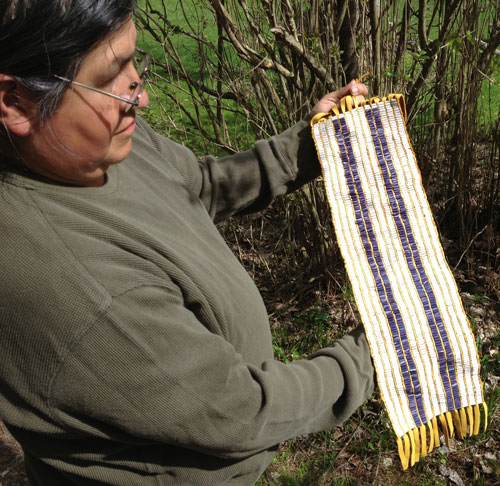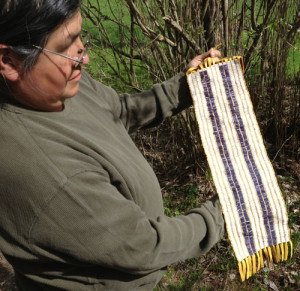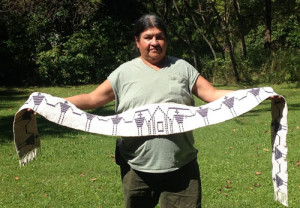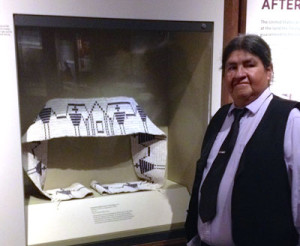
Oñgwaweñna’
Onondaga Nation- Wah’hasoñhdah, ‘He’s adding on’ is Tony Gonyea’s oñgwehoñwe name. This meaning has taken on a great historical significance in an apparent true expression of his name. He’s adding on to his repertoire of ways. He is always there, supporting our traditional way of life as a Longhouse Faithkeeper. In recent years, Tony, who is Beaver Clan, has also become known as a maker of Haudenosaunee wampum belt replicas.
Onondaga Nation- Wah’hasoñhdah, ‘He’s adding on’ is Tony Gonyea’s oñgwehoñwe name. This meaning has taken on a great historical significance in an apparent true expression of his name. He’s adding on to his repertoire of ways. He is always there, supporting our traditional way of life as a Longhouse Faithkeeper. In recent years, Tony, who is Beaver Clan, has also become known as a maker of Haudenosaunee wampum belt replicas.
Skilled artistry, patience, and a keen ability to figure out how something is made, are characteristics needed for an art form not shared by many. Tony was an art major at Onondaga Community College enjoyed pen and ink drawing, and today continually sketches people and places wherever he goes.
“I’ve always been an artist,” said Tony Gonyea. “Carving wood and stone to see what I could make out of a chunk of soapstone or alabaster was always enjoyable to me.”
His work as Onondaga Nation’s representative and contact for NAGPRA (Native American Graves and Repatriation) and Federal Law Section 106 matters led to many interactions with museums and individuals who might have wampum to return to the Nation. Many were interested in using wampum images to promote indigenous views.
After studying and practicing the techniques needed, Tony began replicating wampum belts in 2012.
“The Onondaga Historical Association in Syracuse agreed to return true wampum in exchange for a belt created in the same image,” recalled Tony. “I use beads that closely resemble the real quohog shell bead. When I was done, the belt looked just like the one they returned to us.”
Soon similar arrangements followed.
Tony made replica wampum belts with the Cayuga Museum in Auburn. The Onondaga Council requested a belt that was gifted to Congressman Dan Maffei and now is displayed in his Congressional office. The Skanoñh Center by Onondaga Lake requested a Guswentah belt. Tony has been busy keeping up with the requests ever since. He has belts at the Onondaga Nation School, the New York State Museum in Albany and his most recent accomplishment, the National Museum of the American (NMAI) in Washington, DC.
In making belts Tony uses ceramic beads and leather strips weaved intricately by counting bead by bead a pattern that carries a message created hundreds of years ago. As the length slowly increases, he devised a board with hooks to keep the rows uniform.
Tony explains, “It takes hours upon hours into the evening. Working a little at a time, but when a belt is finished the end product is amazing. It feels nearly as powerful as the original.”
The belts of the Haudenosaunee represent our identity; two of the most well-known and used are the Hiawatha Belt and Guswentha- or Two Row. The Guswentha belt made by Tony and commissioned by the Skanoñh center was carried by the paddlers on the journey to the United Nations in the summer of 2013, commemorating 400 years of the treaty. The image and meaning of treating each other with respect has spread outside the Confederacy as our people carry our messages; making truth in history a priority.
The new exhibit at NMAI, Nation to Nation, begins with Tony’s replica of Guswentha, and with informative panels and video that tell our indigenous view as well as the view of the newcomers to this land, give the viewer the opportunity to draw his/her own conclusions. The Canandaigua Treaty, signed in 1794 is included in the new exhibit, is on loan from the National Archives. The counterpart, the treaty belt commissioned by George Washington for Canandaigua is represented by a replica created by Tony this summer and is over seven feet long. Haudenosaunee leaders are among the vibrant visuals drawing the public to the displays.
“Our belts carry important information that has been long lacking from American society,” added Tony. “These belts are an important tool in educating people about us.”
During the brief reception, Tony answered questions of Smithsonian patrons and individuals interested in knowing more about our belts. The exhibit takes a big step toward educating the public about indigenous peoples. Our struggles and continuing way of life are finally taking a place in history.
In that regard, Tony is doing his part, adding on.



